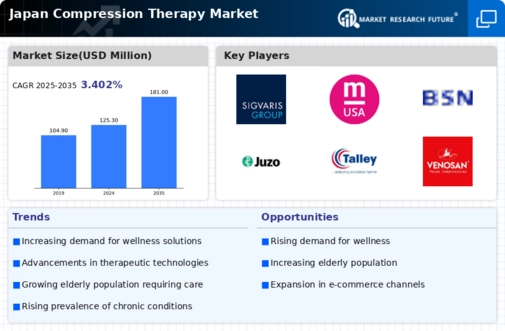Aging Population
The aging population in Japan is a critical driver for the compression therapy market. As the demographic shifts towards an older age group, the prevalence of chronic conditions such as venous insufficiency and lymphedema increases. This demographic trend suggests a growing demand for compression therapy products, which are essential for managing these conditions. According to recent statistics, approximately 28% of Japan's population is aged 65 and older, indicating a substantial market potential. The compression therapy market is likely to see a significant uptick in product adoption as healthcare providers focus on improving the quality of life for elderly patients. Furthermore, the government’s initiatives to promote health and wellness among seniors may further bolster the market, creating opportunities for innovative compression solutions tailored to this demographic.
Technological Innovations
Technological innovations in the compression therapy market are reshaping product offerings and enhancing patient outcomes. Advances in materials and design have led to the development of more effective and comfortable compression garments. For instance, the introduction of smart textiles that monitor patient compliance and provide real-time feedback is gaining traction. This trend indicates a shift towards personalized therapy solutions, which could significantly impact the compression therapy market. As healthcare providers increasingly adopt these innovative products, the market is likely to expand, driven by the demand for enhanced therapeutic efficacy and patient satisfaction. Furthermore, the collaboration between manufacturers and technology firms may lead to the emergence of new products that cater to specific patient needs, thereby diversifying the market.
Rising Healthcare Expenditure
Japan's rising healthcare expenditure is another significant driver for the compression therapy market. With healthcare spending projected to reach approximately $500 billion by 2025, there is an increasing focus on preventive care and management of chronic diseases. Compression therapy products are recognized for their effectiveness in preventing complications associated with venous disorders, which aligns with the healthcare system's emphasis on cost-effective treatments. The compression therapy market stands to benefit from this trend, as healthcare providers and insurers are likely to invest more in therapies that reduce hospitalizations and improve patient outcomes. Additionally, the integration of compression therapy into standard treatment protocols may further enhance its adoption, leading to a more robust market landscape.
Government Support and Regulations
Government support and regulations play a crucial role in shaping the compression therapy market in Japan. The Japanese government has implemented various policies aimed at improving healthcare access and quality, which includes the promotion of effective treatment options for chronic conditions. Regulatory frameworks that facilitate the approval and reimbursement of compression therapy products are likely to enhance market growth. The compression therapy market may experience increased investment as manufacturers align their products with government standards and guidelines. Furthermore, initiatives aimed at encouraging research and development in this field could lead to innovative solutions that meet the evolving needs of patients. As a result, the market is poised for expansion, driven by supportive policies and a favorable regulatory environment.
Increased Awareness of Chronic Conditions
The increased awareness of chronic conditions among the Japanese population is a pivotal driver for the compression therapy market. Educational campaigns and healthcare initiatives have heightened public understanding of venous diseases and their management. This growing awareness is likely to lead to higher demand for compression therapy products, as individuals seek effective solutions for their health issues. The compression therapy market is expected to benefit from this trend, as more patients recognize the importance of preventive measures and early intervention. Additionally, healthcare professionals are increasingly recommending compression therapy as a standard treatment option, further solidifying its role in chronic disease management. This shift in perception may result in a more proactive approach to health, ultimately driving market growth.

















Leave a Comment